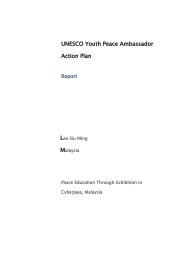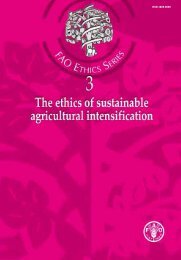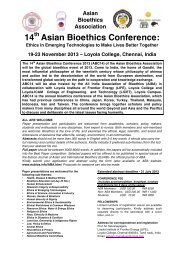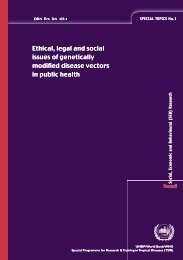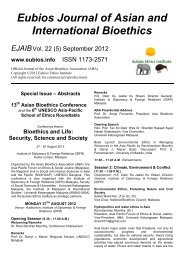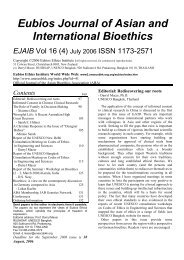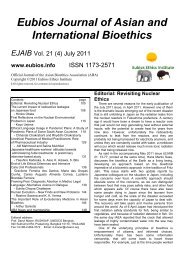Eubios Journal of Asian and International Bioethics - Eubios Ethics ...
Eubios Journal of Asian and International Bioethics - Eubios Ethics ...
Eubios Journal of Asian and International Bioethics - Eubios Ethics ...
Create successful ePaper yourself
Turn your PDF publications into a flip-book with our unique Google optimized e-Paper software.
6 <strong>Eubios</strong> <strong>Journal</strong> <strong>of</strong> <strong>Asian</strong> <strong>and</strong> <strong>International</strong> <strong>Bioethics</strong> 22 (January 2012)<br />
914.for the National Sex Ratio for the year 2011. In<br />
some States it has dropped to about 750 girls.<br />
Cultural <strong>and</strong> social Implications<br />
In India like many other countries the word marriage is<br />
used to denote the legal union between one man <strong>and</strong><br />
one woman. When the sex ratio worsens to 1000 males<br />
to 700 (10 to 7) females then there may be new changes<br />
in Indian cultural <strong>and</strong> social values. If the meaning <strong>of</strong><br />
marriage remains unchanged then it means that there<br />
can be only 7 marriages i.e. 7 boys could marry 7 girls.<br />
Naturally 3 boys may have to remain unmarried. The<br />
marriage market would carry the sign board “No more<br />
stock” <strong>of</strong> girls. When University students were apprised<br />
<strong>of</strong> such a future situation their responses were disturbing.<br />
They indicated that cohabitation, polygamy/poly<strong>and</strong>ry,<br />
sexual revelry among male partners <strong>and</strong> the like may be<br />
<strong>of</strong> common occurrence. To meet the shortage <strong>of</strong> ‘wife’<br />
one could adopt the concept <strong>of</strong> ‘part-time wife’. Currently<br />
there has been legal proceedings on the viability <strong>of</strong><br />
homosexual sexual-lifestyles in Indian context (Trivedi,<br />
2012; Venkatesan, 2012).<br />
As sex ratio worsens<br />
The latest 2011 census recorded the lowest ever child<br />
sex ratio <strong>of</strong> 914 females to every 1000 males. It is a<br />
decline from the 1971 census from 940. In the face <strong>of</strong><br />
imbalance in the present sex ratio <strong>and</strong> with an<br />
expectation that it will deteriorate further the Planning<br />
Commission panel put forwarded a taboo proposal in<br />
order to prevent a major shift in policies. According to a<br />
Planning Commission member Syeda Hamid “Instead <strong>of</strong><br />
totally banning sex determination, which the government<br />
has failed to do, it would be a better idea to be flexible on<br />
allowing sex determination — if families so choose —<br />
<strong>and</strong> in case it is a female foetus, the government will<br />
‘adopt’ it,”<br />
The idea behind the Commission’s proposal to relax<br />
the legal ban for rural areas as part <strong>of</strong> a programme <strong>of</strong><br />
“adopting” female foetuses <strong>and</strong> generously incentivising<br />
families <strong>and</strong> health workers to ensure the safe delivery <strong>of</strong><br />
girl babies (Dhar, 2011). On the other h<strong>and</strong> the All India<br />
Democratic Women’s Association (AIDWA) strongly<br />
condemned the Planning Commission’s proposal to<br />
promote the “adoption” <strong>of</strong> unwanted female foetuses in a<br />
bid to stem the continuous decline in child sex ratios. The<br />
Commission’s move to relax the ban in the name <strong>of</strong><br />
“flexibility <strong>and</strong> choice” tantamount to accepting the<br />
argument that sex selection is a matter <strong>of</strong> “freedom <strong>of</strong><br />
choice”, which has already been struck down by the<br />
courts while upholding the PC&PNDT Act.<br />
Census data from 1971 to 2011 show that PC&PNDT<br />
Act has not been effective. The St. John’s Academy <strong>of</strong><br />
Health Sciences (SJAHS), Bangalore in South India held<br />
a series <strong>of</strong> lecture programs in collaboration with the<br />
Center for Global Health Research (CGHR) on the 16 th<br />
Dec. 2011. One session was “12 Million Missing Girls in<br />
India: New Evidence on Selective Abortions”. The<br />
number <strong>of</strong> persons killed in the practice <strong>of</strong> female<br />
foeticide is a clear case <strong>of</strong> genocide <strong>and</strong> could exceed<br />
any previous count in any other country.<br />
<strong>Asian</strong> culture transported to the West<br />
The Interim Editor in Chief <strong>of</strong> Canadian Medical<br />
Association <strong>Journal</strong> begins with a humor the sad episode<br />
<strong>of</strong> female foeticide in India <strong>and</strong> in Canada <strong>and</strong> America.<br />
Indian immigrants to the West not only brought taste<br />
curry recipes but also nasty cultural practice <strong>of</strong> female<br />
infanticide <strong>and</strong> its variations. It his editorial entitles “It’s a<br />
girl!— could be a death sentence” (Kale, 2012).<br />
In Asia selective abortion is practiced <strong>and</strong> the victim is<br />
always the unwanted female foetus. <strong>Asian</strong>s <strong>of</strong> Sikh,<br />
Hindu <strong>and</strong> Chinese descent who have settled in Canada<br />
do practice sex selection (Picard, 2012). Even though<br />
child bearing <strong>and</strong> upbringing <strong>of</strong> children are expensive<br />
across the globe, the conception <strong>and</strong> birth <strong>of</strong> a female<br />
baby is the most unwelcomed event. The practice <strong>of</strong><br />
giving <strong>and</strong> taking dowry will swindle a family’s financial<br />
resources. In India, since 1997, a medical doctor is<br />
barred from disclosing the sex <strong>of</strong> the baby when the<br />
mother is subjected to ultrasounds <strong>and</strong> amniocentesis<br />
procedures. It raises yet another bioethical issue <strong>of</strong><br />
women’s right to know about even the small details <strong>of</strong> her<br />
pregnancy. But the message can be (is) conveyed<br />
through nonverbal methods. Therefore, it is difficult to<br />
enforce the existing law which prevents the disclosure <strong>of</strong><br />
the sex <strong>of</strong> the foetus. In Canada a blanket ban on sexselective-abortion<br />
would be unethical since all Canadians<br />
are not guilty <strong>of</strong> such a practice. It is only the <strong>Asian</strong><br />
communities <strong>of</strong> Asia settled in Canada.<br />
Dr. Rajendra Kale <strong>of</strong> the Canadian Medical Association<br />
<strong>Journal</strong> highlighted the global problem <strong>of</strong> female feticide<br />
that happens in India <strong>and</strong> China by the millions. He<br />
pointed out that “it also happens in North America in<br />
numbers large enough to distort the male to female ratio<br />
in some ethnic groups. Should female feticide in Canada<br />
be ignored because it is a small problem localized to<br />
minority ethnic groups? No. Small numbers cannot be<br />
ignored when the issue is about discrimination against<br />
women in its most extreme form. This evil devalues<br />
women. How can it be curbed? Therefore he has “called<br />
for a ban on disclosing the sex <strong>of</strong> a foetus until 30 weeks,<br />
at which point it is difficult to obtain an abortion” (Kale,<br />
2012). Such stringent laws only lead to black-marketing<br />
in sex selective abortion. On the other h<strong>and</strong>, the National<br />
body representing Canada’s obstetricians <strong>and</strong><br />
gynecologists “contends that Dr. Kale’s proposal flies in<br />
the face <strong>of</strong> accepted st<strong>and</strong>ards for patient care <strong>and</strong> fails<br />
to acknowledge that changing deep-rooted cultural<br />
beliefs, not imposing heavy-h<strong>and</strong>ed restrictions, is the<br />
key (Friesen, 2012).<br />
It is unclear why American <strong>and</strong> Canadian citizens <strong>of</strong><br />
Indian <strong>and</strong> <strong>Asian</strong> origin should resort to sex-selectionabortion<br />
when there is no economic hardship. According<br />
to Kale’s editorial that in U.S. 40% <strong>of</strong> 65 female Indian<br />
immigrants “had previously aborted a female fetus <strong>and</strong><br />
90 per cent <strong>of</strong> those currently pregnant with a girl had<br />
pursued the idea <strong>of</strong> abortion” (Kale, 2012; Friesen,<br />
2012).<br />
The practice <strong>of</strong> sex-selective-abortion is a combination<br />
<strong>of</strong> cultural, social <strong>and</strong> spiritual problem <strong>and</strong> it can’t be<br />
healed through law. Giving <strong>and</strong> taking dowry is illegal by<br />
a Government ban. But still the name dowry has been<br />
changed to ‘gift’. Somehow the parents <strong>of</strong> a girl want to




